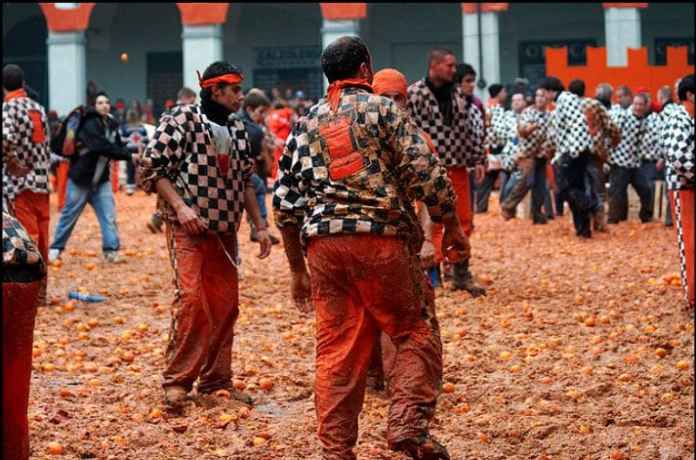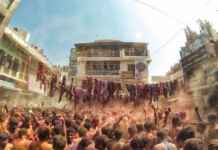As the name suggests, The Battle of the Oranges is the recreation of a historic fight held in the tiny northern city of Ivrea in the Turin province. It wouldn’t be wrong to call it an orange version of Valencia’s famed La Tomatina. Approximately 500,000 kilogram stockpiles of fresh oranges are collected for Battaglia delle Arance, the fight between townsfolk and a ruling tyrant.
Regarded as the centre of the Canavese area, Ivrea is a town of the province of Turin in the Piedmont region of northwestern Italy. In order to attend the Battle of the Oranges, it is recommended that visitors reach Turin. Turin has an airport of its own and is well connected with the rest of the world via flights. After landing at Turin, Ivrea is at a distance of 40 minutes, north from Turin and can be easily accessed by car or public transport.
The origins of The Battle of the Oranges can be traced to a medieval legend, according to which the Lord of Ivrea made an attempt to rape the daughter of a miller, thereby exercising his droit du seigneur (right of the lord) to take the virginity of his serfs’ daughters. It was the eve of her wedding. However, the Lord’s plan backfired and the girl managed to decapitate him. The miller’s daughter also set the town free from his oppression, after facing a massive struggle from the Lord’s followers.
Since that day, “the lord’s followers” travel in carts wearing jesters’ outfits, and the “commoners” are on their feet in sporting uniforms. The miller’s daughter, Violetta, is represented by a woman dressed in white and a crimson-red headdress. For the battle, the townsfolk are divided into roughly nine competitive teams of almost 4,000 members each.
The Battle of the Oranges takes place the Sunday, Monday and Tuesday (Mardi Gras) before Ash Wednesday. On the evening prior to the battle, a joyous procession pays respect to the woman representing Violetta, the miller’s daughter for that year. The orange battle begins at 2pm the next day.
Dressed in their battle attire, the teams make their way to streets of Ivrea that are designated for war. Over the course of the next three days, men, women and children hurl oranges at each other, attempting to “kill” the other teams. After the three days of carnage, one of the generals of the teams ends the war, and the event is followed by a massive funeral on Fat Tuesday.
The battle concludes on Mardi Gras, when awards are given to the top-performing teams. These prizes and positions are determined by judges patrolling the piazzas and by the defenders themselves. At the end of the Battle of the Oranges, a sword-wielding Violetta watches over a burning scalo. A scalo is usually a pole with juniper and heather bushes. If the scarlo burns fast and bright, it is understood that the future would be good whereas a slow burn is a bad omen for the upcoming year.
As far as participating in the battle is concerned, one needs to be part of a foot-soldier mercenary group to be in battle. However, just wander into the battle zone, remove your red cap and get ready to be pelted by oranges!













